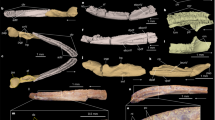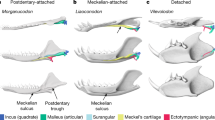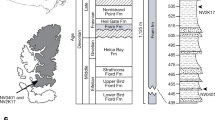Abstract
CAECILIANS are elongate, limbless, mostly fossorial amphibians. Less well known than frogs and salamanders, they are represented today by about 34 genera and 162 species1. Until recently, the fossil record of caecilians consisted of only two vertebrae, one from the Palaeocene of Brazil2, the other from the Late Cretaceous of Bolivia3. We report here the discovery of an extensive series of Early Jurassic caecilians which extends the fossil record of the group and reveals numerous features, including limbs, that are unknown among modern species. Although the new taxon possesses a tentacular fossa for a chemosensory organ and specializations of the jaw apparatus that are uniquely caecilian, other derived features are shared with salamanders and, among extinct Palaeozoic forms, with microsaurs. The configuration of the skull roof, which differs from the fenestrated condition typical of frogs, salamanders and putatively primitive living caecilians, is evidence of substantial evolutionary divergence between caecilians and other modern amphibian groups.
This is a preview of subscription content, access via your institution
Access options
Subscribe to this journal
Receive 51 print issues and online access
$199.00 per year
only $3.90 per issue
Buy this article
- Purchase on Springer Link
- Instant access to full article PDF
Prices may be subject to local taxes which are calculated during checkout
Similar content being viewed by others
References
Duellman, W. E. & Trueb, L. Biology of Amphibians (McGraw-Hill, New York, 1986).
Estes, R. & Wake, M. H. Nature 239, 228–231 (1972).
Rage, J.-C. C. r. Acad. Sci. Paris Ser. II 302, 1033–1036 (1986).
Billo, R. & Wake, M. H. J. Morph. 192, 101–111 (1987).
Nussbaum, R. A. Occ. Pap. Mus. Zool. Univ. Mich. 682, 1–30 (1977).
Wake, M. H. & Wurst, G. Z. J. Morph. 159, 331–341 (1979).
Carroll, R. L. & Gaskill, P. Mem. Am. phil. Soc. 126, 1–211 (1978).
Wake, M. H. J. Morph. 165, 117–130 (1980).
Carroll, R. L. & Currie, P. J. Zool. J. Linn. Soc. 57, 229–247 (1975).
Trueb, L. & Cloutier, R. in Origins of the Higher Groups of Tetrapods: Controversy and Consensus (eds Schultze, H.-P. & Trueb, L.) 223–313 (Comstock, Ithaca, 1991).
Evans, S. E., Milner, A. R. & Mussett, F. Geobios 21, 539–552 (1988).
Rage, J.-C. & Roček, Z. Palaeontographica (Abt. A) 206, 1–16 (1989).
Wake, D. B. & Lawson, R. J. Morph. 139, 251–298 (1973).
Wilkinson, M. Z. zool. Syst. Evolut.-forsch. 29, 304–311 (1991).
Wake, M. H. & Hanken, J. J. Morph. 173, 203–223 (1982).
Holmes, R. Phil. Trans. R. Soc. B306, 431–524 (1984).
Bemis, W. E., Schwenk, K. & Wake, M. H. Zool. J. Linn. Soc. 77, 75–96 (1983).
Nussbaum, R. A. J. Zool. Lond. 199, 545–554 (1983).
Author information
Authors and Affiliations
Rights and permissions
About this article
Cite this article
Jenkins, P., Walsh, D. An Early Jurassic caecilian with limbs. Nature 365, 246–250 (1993). https://doi.org/10.1038/365246a0
Received:
Accepted:
Issue Date:
DOI: https://doi.org/10.1038/365246a0
This article is cited by
-
Triassic stem caecilian supports dissorophoid origin of living amphibians
Nature (2023)
-
The Lissamphibian Fossil Record of South America
Palaeobiodiversity and Palaeoenvironments (2023)
-
Mesozoic and Palaeocene lissamphibian assemblages of North America: a comprehensive review
Palaeobiodiversity and Palaeoenvironments (2013)
-
Chinese salamanders tell tales
Nature (2001)
-
An Early Jurassic jumping frog
Nature (1995)
Comments
By submitting a comment you agree to abide by our Terms and Community Guidelines. If you find something abusive or that does not comply with our terms or guidelines please flag it as inappropriate.



